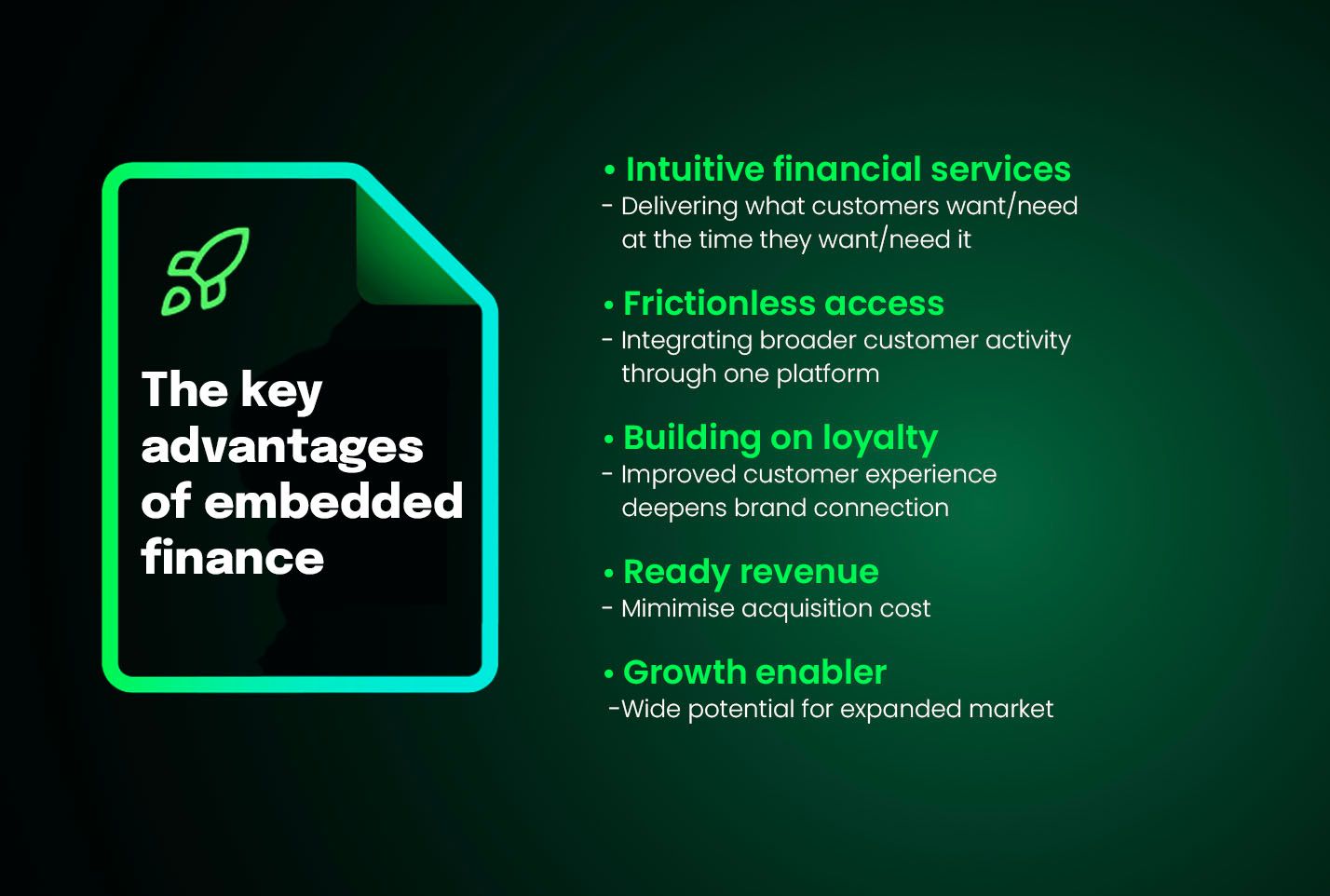Embedded Finance and AI Integration. ‘AI out of the box’ - Efficient and relevant diversification
“The financial system of the future won’t be built in banks — it’ll be embedded in the apps, platforms and services people already use. Redefining how financial services are accessed and delivered, embedded finance is at the forefront of fintech innovation”. - Tariq Bin Hendi – World Economic Forum, April 2025
May 22, 2025
Insights

By integrating financial services into non-financial platforms, services or apps, embedded finance is giving existing customers access to additional or complementary services with their preferred brand. Not only retaining their loyalty by keeping them within a company’s ecosystem but creating a more cohesive user experience.
Embedded finance has experienced stellar trajectory in response to four key factors: the shift in consumer behaviour, the preferential status and influence of digital platforms, the continued pressure from agile fintechs and the perpetually evolving regulatory landscape. It’s no longer a question of when, but of how quickly businesses can engage.
1. The influence of embedded finance
The financial landscape is continually evolving, influenced by how consumers interact with brands and conduct financial transactions for both functional and discretionary spending.
The benefits and trust signals associated with established institutions like banks, are offset by the lack of responsiveness and perceived lack of understanding in responding to customer behaviour.
Legacy systems and risk tolerances further complicate the path to delivering value to existing customers. Paired with the rise of digital platforms to infrastructure – connecting consumer activity instantly and invisibly, providing seamless transaction pathways that remove the friction of having to switch between platforms.
Enter embedded finance. A fast track to contemporary consumer relevance and business sustainability. Facilitated by technology providers whose API platforms provide the connective tissue between brand and funding resource.
Customers are increasingly expecting more tailored financial solutions, faster.
For most companies, diversification is as much a part of their digital transformation aspirations as efficiency. Creating space for new verticals that deliver a different cohort of customers, an expanded offering also adds value to an existing customer base - serving them additional benefits, conveniently within their preferred digital interface.
For traditional institutions that are slow to mobilise, keeping a customer’s business is more about adapting to offer new products and services than changing existing ones.
As a younger generation of consumers matures, the way they engage with brands and communicate their value to their peers is equal parts convenience and attitude.
An EY report found that of the 20 global financial technology leaders surveyed,
94% believe the key to success is the relevance of a financial product in addressing customers’ real-time needs.
Keeping an existing customer engaged requires investment. Acquiring a deep understanding of the landscape in which they operate to gain access to their predictive interests and help to steer them.
This is only the start. Taking these insights and using them to deliver a product or service while it’s still relevant requires a significant pivot - and additional resources - creating risk by diverting focus from core competencies. This decision paralysis can be cured through collaboration with a technology partner that understands the financial landscape and has the resources and ability to provide an ‘out of the box’ solution, relieving the significant pressure of development in a truncated timeline.
Recent developments in agentic AI, shows how it’s driving change in customer behaviour by directly influencing interactions and transactions.
Google I/O have introduced a ‘Shop with Ai Mode’, one key feature to change behaviour is the ‘agentic check out’– facilitating purchase as a flow from surfacing search results.
In April of this year, VISA, Mastercard and PayPal announced their agentic commerce capability and Google’s response – Gemini 2.5- is what will supercharge their checkout in search function, redirecting and ‘owning’ customer journeys. The pivotal part of this ‘streamlined checkout’ is in preventing drop off, leaning into the ease of finalising purchase and remove the natural pause.
The landscape is shifting to broaden focus on the environment pre (nurture) and post (value-exchange) purchase – not just how the purchase is finalised. And this level of understanding customer behaviour is influencing the ‘convert’ part of the cycle and directly impacting technology focus.

Coopetition: Where previous enemies are now allies
Fintechs evolved from the lack of agility and innovation stifling established institutions.Maturing into competition by offering more responsive, efficient processes, unburdened by legacy, stakeholders and the sheer volume of ingrained systems.
Previous co-existence was improbable - each entity vying over the same pot, perceiving the other as either a threat to one’s existence or future relevance. The strategic need for market relevance has changed this into if not a harmonious marriage, then one of mutual convenience, where the benefits of agility and hyper-focus are complemented by the leveraged equity of established trust, size and access to ready capital.
Fintech x bank strategic partnerships are not only mutually beneficial- playing to each individual strength, but more importantly, have refocused the collective energy on the consumer. Creating responsive solutions is only one side of the benefits equation, simultaneous delivery of what customers are missing, answers the high expectations of the fickle consumer environment.
2. Increasing market value
Embedding financial services gives companies access to new revenue streams with the added benefit of a low customer acquisition cost. An existing consumer base comes ready-primed with a connection– through existing products or services. Additional products integrated with a platform customers are adept at using –creates a seamless experience, natural retention that capitalises on a ‘captive’ audience. The more products a customer indents with one brand, the more ‘sticky’ they are, less vulnerable or inclined to ‘shop around’.
In the B2B environment – this serves as a beacon to potential partners, attracted by ‘out of the box’ convenience. And if that same technology partner’s product comes with security updates, built in governance and cyber security protocols – partners reap the benefits of scale.
Financial services embedded into e-commerce and other software platforms accounted for $2.6 trillion, or nearly 5%, of total US financial transactions in 2021, and our research predicts, that by 2026, it will exceed $7 trillion.
Bain & Company
3. AI: Extracting value from data
Delivering a product to market is only the visible. Beneath the surface lies the customer transactional data that when harnessed, can transform into actionable insights. And the more data points, the more accurate and effective the insights - providing opportunity to better respond to customer interests.
Shantell Williams, Tiimely's Chief Technology Officer notes "Predictive analytics is transforming financial services by enabling businesses to anticipate customer needs, optimise risk management, and make faster, more accurate decisions. It’s not just about analysing past behaviour - it’s about proactively shaping better financial outcomes."
AI has established its place in the financial sector through deep competency in risk assessment, fraud detection and the ability to curate customer experiences that are hyper-personal. While trust has presented a challenge when it comes to personal financial data, the prevalence of digital platforms facilitating financial transactions and tighter regulatory parameters has supported this move into the mainstream. This will continue to improve with transparency, preemptively addressing consumer concerns, allowing AI to scale its efficacy – processing increasing amounts of data with greater accuracy and without requiring additional resources.
Summary
As with any digital transformation or diversification, relevance is key. The ability to capitalise on market trends and consumer preferences, paired with a cogent brand extension on a familiar interface, is an altogether compelling proposition.
• Embedding finance enables diversification, a prudent competitive strategy
• Consumers don’t just want access, they expect it to be personalised and seamless, enabling them to transact with ease.
• Technology plays a vital role in ensuring safe, compliant, and trusted products are seamlessly integrated into relevant customer journeys.
• AI and data fluency, transparency and preemptively addressing concerns builds trust allowing AI to expand its versatility.
To take advantage of this market opportunity requires flexible thinking, a more agile business strategy and adapting swiftly to a world that is increasingly hyper-personalised in real time.
Partnering with a proven partner like Tiimely, who, as a digital native technology company has deep domain expertise and eight years of real-world credit data powering its platform means less reliance solely on predictive AI. Machine-learning capability with seamless ingestion of the most recent updates, built-in governance tailored to individual risk tolerances, and cyber-sec as standard, is key to market entry at speed. With Tiimely’s ‘out of the box’ security and compliance, potential risk is addressed- supercharging your entry and sustainability in market.